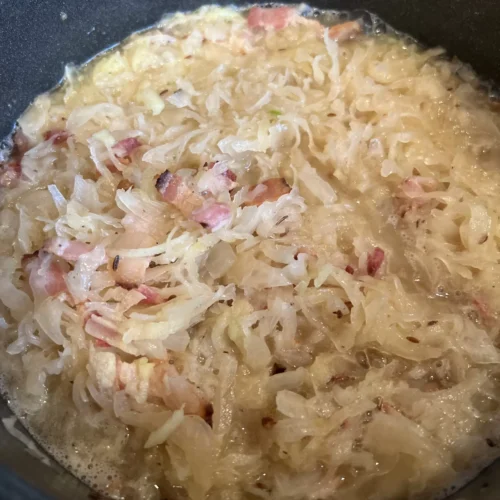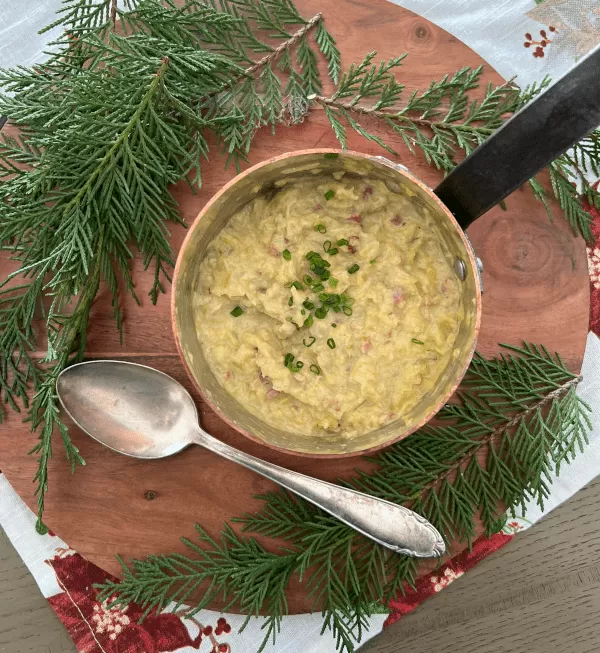Sauerkraut is one of those dishes that has always been close to my heart. Growing up with a strong connection to German cuisine, I’ve enjoyed it in many forms, but there’s something special about Bavarian-style sauerkraut that sets it apart. It’s a dish that takes the sharp, tangy flavors of traditional sauerkraut and mellows them into something warm, comforting, and deeply satisfying. When done right, Bavarian-style sauerkraut is the perfect side dish for a hearty meal, and it’s a great way to bring a little bit of German tradition into your kitchen.

The Taste of Bavarian-Style Sauerkraut
At its core, Bavarian-style sauerkraut is about balance. Traditional sauerkraut, straight out of the jar or can, has a sharp, briny bite that can be quite intense. While that punch of acidity is something I love in the right context, Bavarian-style sauerkraut is all about softening those edges. Through slow cooking and the addition of a few key ingredients, the sauerkraut becomes milder, sweeter, and more complex in flavor. It’s a transformation that turns sauerkraut from a simple condiment into a side dish that can hold its own alongside roasted meats, sausages, or even as a component of a more elaborate meal.
The Importance of Quality Sauerkraut
Before diving into the cooking process, it’s important to talk about the main ingredient: sauerkraut. As with any dish, the quality of your ingredients will have a huge impact on the final result, and sauerkraut is no exception. If you have the time and inclination, I highly recommend making your own sauerkraut at home. The process is relatively simple, and the results are well worth the effort. Homemade sauerkraut tends to have a fresher, more vibrant flavor than the store-bought varieties, and you can customize it to your liking. If you’re interested in trying your hand at making sauerkraut from scratch, you can follow this recipe.
However, if you’re short on time or prefer to buy pre-made sauerkraut, it’s important to choose a high-quality product. Look for a German brand that ferments its sauerkraut with wine, like Hengstenberg Weinkraut. The addition of wine during the fermentation process gives the sauerkraut a subtle, nuanced flavor that pairs beautifully with the other ingredients in this dish. Avoid the overly processed, canned varieties that are often too sour or bland; instead, opt for something that has been naturally fermented and retains the authentic flavors of traditional sauerkraut.
The Transformation: From Sharp to Mellow
One of the things I love most about Bavarian-style sauerkraut is the way the cooking process transforms the sauerkraut from something sharp and tangy into something mellow and complex. When you first taste sauerkraut straight out of the jar, it can be quite intense—briny, sour, and sharp. While that intensity is great for some dishes, it can be overpowering on its own.
But when you cook sauerkraut slowly, with the addition of onions, apples, and beer, something magical happens. The acidity softens, the flavors meld together, and the sauerkraut takes on a whole new character. The sweetness of the onions and apples balances the tanginess, while the beer and spices add depth and warmth. The bacon adds a savory, smoky element that ties everything together, making the dish richer and more satisfying.
The result is a sauerkraut that’s still tangy, but in a way that’s more rounded and mellow. It’s no longer just a sharp, acidic punch—it’s a harmonious blend of flavors that’s comforting, satisfying, and incredibly delicious. Whether you’re serving it with a traditional German meal or incorporating it into a more modern dish, Bavarian-style sauerkraut is a versatile side that adds a unique, comforting flavor to any plate.
A Dish for All Seasons
Bavarian-style sauerkraut is a dish that can be enjoyed year-round, but it’s particularly comforting during the colder months. There’s something about the warm, savory flavors that makes it the perfect accompaniment to hearty winter meals. Whether you’re serving it alongside a roast, pairing it with sausages, or even enjoying it with a simple loaf of crusty bread, this sauerkraut is a dish that brings warmth and comfort to the table.
But don’t think that sauerkraut is just for winter! It’s also a fantastic dish to serve during the summer months, especially if you’re grilling. Bavarian-style sauerkraut pairs beautifully with grilled sausages and meats, adding a tangy, flavorful contrast to the smoky, charred flavors of the grill. It’s a great way to add a touch of German tradition to your summer barbecues, and it’s sure to be a hit with guests.

Ingredients for Bavarian-Style Sauerkraut
- Sauerkraut: 1 jar (24-32 oz) of high-quality sauerkraut (homemade or a German brand like Hengstenberg Weinkraut)
- Onions: 1 large onion, finely chopped
- Apples: 1 large apple, peeled, cored, and grated or finely chopped (Granny Smith or Braeburn are great choices)
- Caraway Seeds: 1 tablespoon
- Juniper Berries: 4-6 juniper berries, crushed
- Thick-Sliced Bacon: 4 thick slices, cut into chunks
- Brown Sugar: 1/2 tsp
- Beer: 1 cup of German lager or Märzen
- Salt: 1/8 tsp
- Pepper: To taste
Instructions for Bavarian-Style Sauerkraut
- Prepare the Bacon: In a large pot or Dutch oven, add the thick-sliced bacon chunks. Cook them over medium heat until the fat begins to render, and the bacon starts to brown. The bacon should be slightly crisp on the edges but still tender in the center.
- Cook the Onions: Once the bacon is browned, add the finely chopped onions directly into the pot with the bacon. Cook together over medium heat until the onions become soft and translucent, about 5-7 minutes. The onions will absorb some of the bacon fat, enhancing their flavor.
- Add the Apples: Stir in the grated or finely chopped apple and cook for another 3-4 minutes until the apple begins to soften. The apples will add a natural sweetness that balances the tanginess of the sauerkraut.
- Combine and Season: Add the sauerkraut to the pot, mixing it well with the bacon, onions, and apples. Sprinkle in the caraway seeds and crushed juniper berries, stirring to ensure the ingredients are evenly distributed.
- Pour in the Beer: Pour the beer over the sauerkraut mixture, stirring to combine. The beer will braise the sauerkraut and bacon, adding a rich, complex flavor while helping to mellow the acidity of the sauerkraut.
- Simmer: Reduce the heat to low, cover the pot, and let the sauerkraut simmer gently for 30-45 minutes. Stir occasionally, making sure the sauerkraut doesn’t stick to the bottom of the pot. If the mixture seems too dry, you can add a little more beer or water as needed.
- Finish and Serve: Once the sauerkraut is tender and the flavors have melded together, taste and season with salt and pepper as needed. Serve the Bavarian-style sauerkraut warm, as a side dish to roasted meats, sausages, or other hearty fare.
This method of braising the bacon directly in the sauerkraut allows the rich, smoky flavors to fully infuse into the dish, creating a deeply satisfying and comforting side that’s perfect for any occasion.

Bavarian Style Sauerkraut
Ingredients
- 1 24-32 oz jar Sauerkraut High-quality sauerkraut (homemade or a German brand like Hengstenberg Weinkraut)
- 1 small Onion finely chopped
- 1 each Apples peeled, cored, and grated or finely chopped (Granny Smith or Braeburn are great choices)
- 1/2 tbsp Caraway Seeds
- 6 each Juniper Berries: crushed
- 4 thick slices Bacon cut into chunks
- 1 cup Beer German lager or Märzen
- 1/8 tsp Salt
- 1 tsp Brown Sugar
Instructions
Prepare the Bacon:
- In a large pot or Dutch oven, add the thick-sliced bacon chunks. Cook them over medium heat until the fat begins to render, and the bacon starts to brown. The bacon should be slightly crisp on the edges but still tender in the center.
Cook the Onions:
- Once the bacon is browned, remove with a slotted spoon and reserve. Add the finely chopped onions directly into the pot. Cook over medium heat until the onions become soft and translucent, about 5-7 minutes. The onions will absorb some of the bacon fat, enhancing their flavor.
Add the Apples:
- Stir in the grated or finely chopped apple and cook for another 3-4 minutes until the apple begins to soften. The apples will add a natural sweetness that balances the tanginess of the sauerkraut.
Combine and Season:
- Add the bacon and sauerkraut to the pot, mixing it well with the onions, and apples. Sprinkle in the caraway seeds and crushed juniper berries, stirring to ensure the ingredients are evenly distributed.
Pour in the Beer:
- Pour the beer over the sauerkraut mixture, stirring to combine. The beer will braise the sauerkraut and bacon, adding a rich, complex flavor while helping to mellow the acidity of the sauerkraut.
Simmer:
- Reduce the heat to low, cover the pot, and let the sauerkraut simmer gently for 30-45 minutes. Stir occasionally, making sure the sauerkraut doesn’t stick to the bottom of the pot. If the mixture seems too dry, you can add a little more beer or water as needed.
Finish and Serve:
- Once the sauerkraut is tender and the flavors have melded together, taste and season with salt and pepper as needed. Serve the Bavarian-style sauerkraut warm, as a side dish to roasted meats, sausages, or other hearty fare.
Frequently Asked Questions (FAQ)
1. Can I make Bavarian-style sauerkraut ahead of time?
Yes, Bavarian-style sauerkraut can be made ahead of time. In fact, the flavors often deepen and improve after a day or two. Store it in an airtight container in the refrigerator and simply reheat it gently on the stove before serving.
2. What type of beer should I use in this recipe?
A good German lager or Märzen is ideal for this recipe. These beers add a subtle bitterness and depth of flavor that complement the sauerkraut. If you prefer, you can also use a malty beer for a richer taste.
3. Can I make this recipe without bacon?
Yes, you can make a vegetarian version by omitting the bacon and using olive oil or butter to sauté the onions and apples. The dish will still be flavorful, though it will lack the smoky, savory notes that bacon adds.
4. What should I serve with Bavarian-style sauerkraut?
Bavarian-style sauerkraut pairs beautifully with roasted pork, sausages, or grilled meats. It’s also excellent with potato dishes like Kartoffelknödel or as part of a traditional German meal with pretzels and mustard.
5. How do I crush juniper berries?
To crush juniper berries, place them in a small plastic bag and use a rolling pin or the flat side of a chef’s knife to press down until they’re slightly broken up. This releases their flavor and makes them easier to incorporate into the dish.




